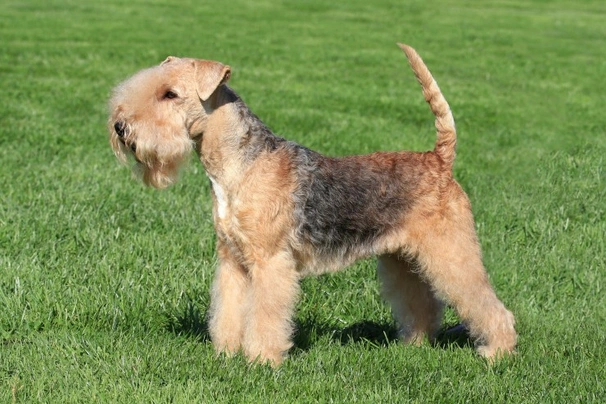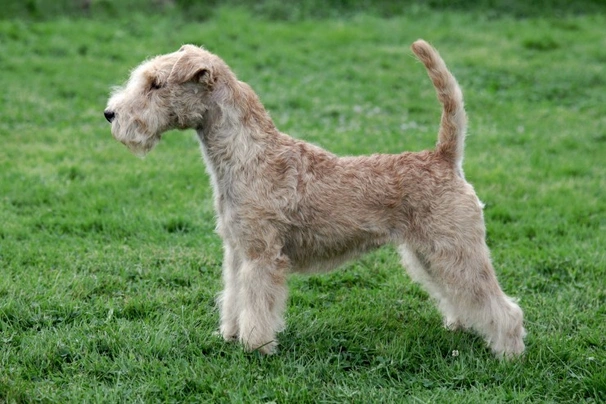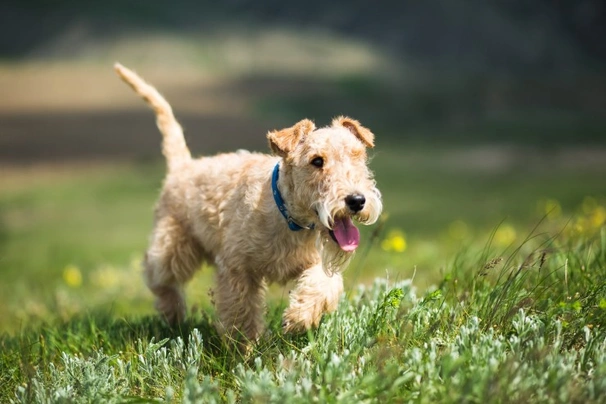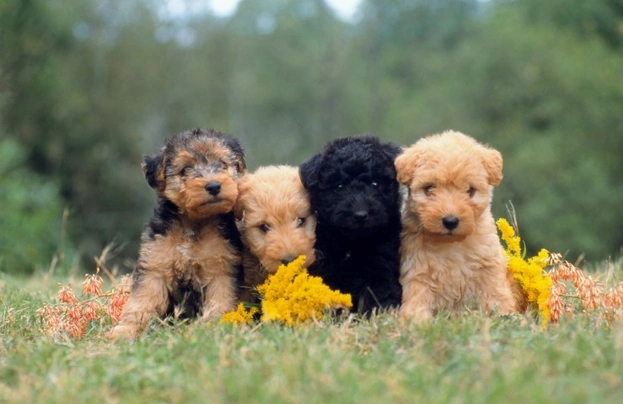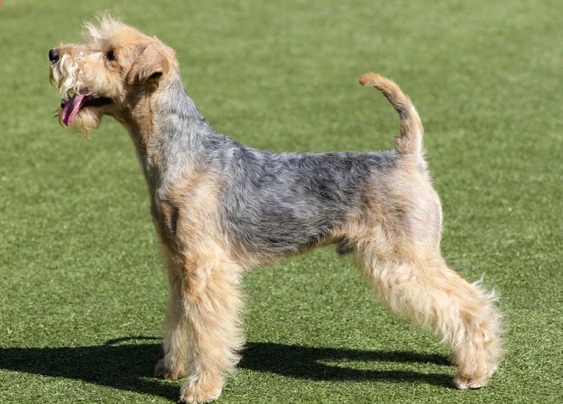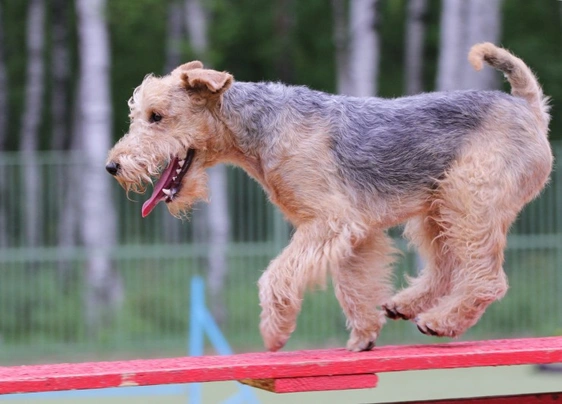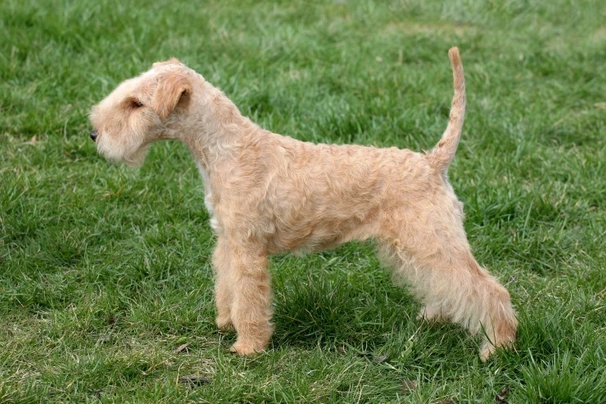Lakeland Terrier
Pros
Cons
Introduction of the Lakeland Terrier
The Lakeland Terrier is often referred to as a cheeky rascal and for good reason because these attractive little dogs boast being mischievous and have a real sense of humour. They are highly adaptable being just at home in a working environment as they are in a family environment providing they are given enough to do combined with lots of daily physical exercise. They are tireless affectionate and extremely loyal terriers that form a very strong bond with their families enjoying nothing more than being involved in everything that goes on in a household.
Sadly today these little dogs are not as popular as they once were and as such they have been placed on The Kennel Club’s list of vulnerable native breeds. However their numbers are rising although anyone wishing to share a home with a Lakeland Terrier would need to go on a waiting list for the pleasure of doing so because not many well-bred puppies are registered with the Kennel Club every year.
History of the Lakeland Terrier
As their name suggests the Lakeland Terrier first appeared on the scene in the Lake District of England in the early 1900's where they were part of "fell packs" of working dogs. They were originally bred to work in mines and on farms but with hunting being a popular sport at the time many types of terriers were used in the field and it is from these dogs that the Lakeland evolved with people wanting to create the "perfect" terrier. The end result was the Lakeland Terrier a cheerful fearless little dog that boasted a tremendous amount of courage loyalty and stamina.
The breed was first exhibited at agricultural shows in the region which did not come under the Kennel Club rules but later the Lakeland Terrier Association was established in 1921 with an end goal being to set out a breed standard. By 1928 members of the now defunct association agreed that Kennel Club recognition should be sought and 3 years later in 1931 championship status was granted.
A year later in 1932 the Lakeland Terrier Club was established and breed enthusiasts began promoting the Lakeland throughout the country. Interest in the breed continued and their numbers rose right up to the beginning of World War II after which time their numbers feel dramatically. At the end of the war dog shows started up again which saw a renewed interest in the Lakeland Terrier. Subsequently breed numbers began to once again rise and by the 1950s Lakelands were winning many of the biggest shows in the land.
Sadly over time the breed has become less popular here in the UK and elsewhere in the world and the numbers of puppies registered with The Kennel Club every year has dwindled. As a result the breed has now been classed as a vulnerable native breed even though they make wonderful family pets and companions being ranked 71 in popularity out of 238 breeds on the Pets4homes website.
Interesting facts about the breed
- Is the Lakeland Terrier a vulnerable breed? Yes they are listed among the vulnerable native breeds by the Kennel Club although they are ranked 71 out or 238 breeds on the Pets4homes website
- Anyone wishing to share their home with a Lakeland might have to go on a waiting list for the pleasure of owning a well-bred Kennel Club registered puppy
- Prospective Lakeland Terrier owners should be aware that tail docking is now banned in England with the law having come into effect on 6th April 2007 in Wales the law came into effect on 28th March 2007 in Scotland there is a total ban which came into effect on 30th April 2007. There are exemptions in place for specific working breeds both in England and Wales but the correct documentation must be provided by a vet to the correct authorities before a dog can undergo a procedure. It is also worth noting that there is a ban on showing dogs with docked tails if the procedure was carried out after the ban came into effect at all paying dog show events but the ban does not apply to working dogs when they exhibit working abilities
Appearance of the Lakeland Terrier
Height at the withers: Males 37 cm Females 37 cm
Average weight: Males 8 kg Females 7 kg
Lakeland Terriers are well-balanced compact and small dogs that boast a sturdy and strong look about them. Their heads are refined with terriers boasting powerful muzzles and strong jaws. their noses are a nice black colour although in liver coated terriers the nose matches the coat. Their eyes are either dark or hazel and their ears are V-shaped and moderately small which these terriers carry very alert. The Lakeland Terrier has a strong jaw with a perfect scissor bite where their upper teeth neatly overlap their lower ones.
Their necks are slightly arched and shoulders well laid back with nice well-boned front legs. Their bodies are compact with these terriers having quite narrow chests and strong backs with powerful muscular hindquarters and strong back legs. Their feet are compact round and well padded. Their tails are set high which dogs carry gaily adding to their overall balance.
When it comes to their coat the Lakeland Terriers has a double coat with a dense and harsh outer coat and a thick extremely weather-resistant undercoat. The accepted breed colours for Kennel Club registration are as follows:
- Black
- Black & Tan
- Blue
- Blue & Tan
- Liver
- Red
- Red Grizzle
- Wheaten
Gait/movement
When a Lakeland Terrier moves their front and back legs are carried forward in a parallel motion with dogs holding their elbows perpendicular to their bodies and their stifles not tuning in or out. Lakelands show a good amount of drive in their hindquarters.
Faults
The Kennel Club frowns on any sort of exaggeration or departure from the breed standard and would judge a fault on how much it affects a dog's overall health and wellbeing as well as their ability to perform.
Males should have both testicles fully descended into their scrotums and it is worth noting that a Lakeland Terrier can be a little shorter or taller as well as slightly lighter or heavier than set out in the Kennel Club breed standard which is given as a guideline only.
Temperament of the Lakeland Terrier
Lakelands are a good choice as family dogs but they are not the best choice for first time owners because they need to be trained and handled by people who are familiar with the breed or this type of hyper-active terrier. Males can be a little aggressive towards other dogs but their female counterparts tend to be more relaxed when they first meet any dogs. They hardy healthy and good around children providing they are well socialised from a young age.
They form very strong bonds with their families and in particular with the person who trains and looks after them. They can be a little wary and aloof when they are around people they don't know but rarely would a Lakeland show any sort of aggressive behaviour towards a stranger preferring to just keep their distance until they feel more comfortable about things.
They boast having a tremendous amount of stamina and being so intelligent these terriers can easily get bored if they are left to their own devices for longer periods of time. They love human companionship and are a great choice for people where one person usually stays home when everyone else is out of the house. As previously mentioned Lakelands have a tremendous amount of stamina and will happily keep going all day long but being adaptable are just as happy to sit indoors when the weather is bad outside.
When very excited by something Lakeland Terriers have the habit of trembling which is referred to as the "Terrier dither" which should not be mistaken for them being nervous or scared of something but rather the fact they are so exuberant about life. The good news is that as a dog ages they tend to quieten down and their trembling decreases over time.
Are they a good choice for first time owners?
Lakeland Terriers make great family pets but they are not the best choice for first time owners because they are better suited to people who are familiar with their specific needs and who have enough time to dedicate to an energetic canine companion that boasts a tremendous amount of stamina.
What about prey drive?
Lakeland Terriers were bred to hunt and go to ground after foxes and even in a home environment they still have a strong high prey drive and will happily chase anything that moves. As such care should always be taken when walking a Lakeland off the lead anywhere they might meet up with wildlife or livestock just in case a dog decides to give chase. Care should also be taken when introducing a Lakeland to smaller animals and pets for the first time.
What about playfulness?
Lakeland Terriers have a very playful and mischievous side to their natures and having so much energy as well as stamina they will happily run around a back garden chasing a ball and playing for hours on end. Gardens need to be ultra-secure to keep a Lakeland in because they are more than capable of squeezing through the smallest of gaps when the mood takes them. They love to entertain and be entertained which makes these small dogs all the more endearing and fun to live with.
What about adaptability?
Lakeland Terriers are highly adaptable dogs and providing they are given enough daily physical exercise combined with as much mental stimulation to prevent boredom from setting in they are just as happy living in an apartment as they are in a house. With this said like most other terrier breeds there is nothing a Lakeland enjoys more than to chase around a secure back garden whenever they can because they love to let of steam.
What about separation anxiety?
Lakeland Terriers form strong ties with their families and dogs are never very happy when they find themselves left on their own for longer periods of time. They are better suited to people who either work from home or in households where one person stays at home when everyone else is out so they are never alone for any length of time which could see a dog suffering from separation anxiety. This can lead to them being destructive around the home which is a dog's way of relieving any stress they are feeling and a way to keep themselves entertained.
What about excessive barking?
Lakeland Terriers are known to be "barkers" which is a trait that needs to be gently curbed when dogs are still young and before it turns into a real problem. However some Lakelands will bark for the sake of it no matter how gently they are told not to when young and more especially if they are bored and not given enough physical daily exercise and mental stimulation to tire them out.
Do Lakeland Terriers like water?
Most Lakeland like swimming and will take to the water whenever they can more especially when the weather is hot. However if anyone who owns a dog that does not like water should never force them to go in because it would just end up scaring them. With this said care should always be taken when walking a Lakeland Terrier off the lead anywhere near more dangerous watercourses just in case a dog decides to leap in and then needs rescuing.
Are Lakeland Terriers good watchdogs?
Lakies are natural watchdogs and are always quick to let an owner know when there are strangers about or when something they don't like is going on in their environment. They tend to be wary and aloof around strangers preferring to keep their distance but rarely would a Lakeland show any sort of aggressive behaviour towards someone but they will stand their ground and bark incessantly to get their owners attention.
Intelligence / Trainability of the Lakeland Terrier
Lakelands are known to be highly intelligent terriers but they don't boast a very good attention span and they can be stubborn when the mood takes them which is why they are better suited to people who are familiar with the breed. Their training and socialisation must start as early as possible because if left too late these little dogs might start to show a more dominant and unruly side to their natures which can make dogs that much harder to handle. With this said they are quite capable of turning a deaf ear to a command if they find something more interesting to get involved in.
In the right hands and with the right amount of socialisation which must include introducing a Lakeland to as many new situations people other animals and dogs as possible once they are fully vaccinated as possible is essential. Much like other terriers they are quite sensitive dogs by nature and as such they do not respond well to any sort of harsh correction or heavy-handed training methods. They do answer well to clicker training and positive reinforcement but they need to be handled firmly and always fairly so that dogs don't get the upper hand.
The key to successfully training a Lakeland Terrier is to always be consistent and to persevere showing a young dog a lot of patience and understanding when their training starts in earnest which ideally should be when a terrier is around 10 weeks old. Many Lakelands have earned Kennel Club Good Citizen Scheme Gold Awards which is proof they can be trained to be obedient well-behaved terriers when they are given the right sort of direction and guidance.
Lakeland puppies are very cute and it is all too easy to let them get away with things at this stage in their lives. However owners must start as they mean to go on because spoiling a Lakeland puppy would lead to a dog showing a more unruly and dominant side to their natures which can make them a lot harder to handle and live with. Owners must set out ground rules for a Lakeland puppy bearing mind that being so intelligent they will always test these from time to time just for the fun of it. The first commands a puppy needs to be taught are as follows:
- Come
- Sit
- Stay
- Quiet
- Leave it
- Down
- Bed
Children and other
Lakelands are highly adaptable terriers and as such they are perfectly at home in a family environment and if anything they thrive on being involved in everything that goes on in a household. They are happy characters by nature and generally behave nicely around children providing they have grown up together. However any interaction between dogs and the kids must be supervised by an adult to make sure playtime does not get too boisterous which could see a child being knocked over and frightened.
These terriers are known to be fearless but rarely would a Lakeland start a fight unless they feel threatened in any way. However they often do not tolerate living with other dogs of the same sex more especially if they are terrier-types too. Care should always be taken when they meet any smaller animals and pets because their strong instinct might just kick in with disastrous results. If they have grown up with a cat in the home they will usually tolerate being around them but a Lakeland would think nothing of chasing cats that venture into their garden.
Health of the Lakeland Terrier
The average life expectancy of a Lakeland Terrier is between 9 and 15 years when properly cared for and fed an appropriate good quality diet to suit their ages.
Lakeland Terriers are known to be healthy and robust dogs that do not appear to be affected by many of the hereditary health issues that afflict many other breeds. However the conditions that seems to affect the breed the most is as follows:
- Primary lens luxation - test available through the Animal Health Trust
- Cataracts
- Persistent pupillary membranes
- Microphthalmia
- Ventricular septal defect
- Legg-Calve-Perthes syndrome
What about vaccinations?
Lakie puppies would have been given their initial vaccinations before being sold but it is up to their new owners to make sure they have their follow-up shots in a timely manner with the vaccination schedule for puppies being as follows:
- 10 -12 weeks old bearing in mind that a puppy would not have full protection straight away but would be fully protected 2 weeks after they have had their second vaccination
There has been a lot of discussion about the need for dogs to have boosters. As such it's best to talk to a vet before making a final decision on whether a dog should continue to have annual vaccinations which are known as boosters.
What about spaying and neutering?
A lot of vets these days recommend waiting until dogs are slightly older before spaying and neutering them which means they are more mature before undergoing the procedures. As such they advise neutering males and spaying females when they are between the ages of 6 to 9 months old and sometimes even when a dog is 12 months old
Other vets recommend spaying and neutering dogs when they are 6 months old but never any earlier unless for medical reasons. With this said many breeds are different and it is always advisable to discuss things with a vet and then follow their advice on when a dog should be spayed or neutered.
What about obesity problems?
Some Lakelands gain weight after they have been spayed or neutered and it's important to keep an eye on a dog's waistline just in case they do. If a dog starts to put on weight it's important to adjust their daily calorie intake and to up the amount of exercise they are given. Older Lakies too are prone to gaining weight and again it's essential they be fed and exercised accordingly because obesity can shorten a dog's life by several years. The reason being that it puts a lot of extra strain on a dog's internal organs including the heart.
What about allergies?
Lakies are not known to suffer from allergies but should a skin issue flare up it's important to have a dog examined by a vet sooner rather than later just in case there is an underlying health issue causing the problem.
Participating in health schemes
All responsible Lakeland Terrier breeders would ensure that their stud dogs are tested for known hereditary and congenital health issues known to affect the breed by using the following scheme:
- Primary lens luxation (PLL) which can be done through the Animal Health Trust (AHT)
What about breed specific breeding restrictions?
Apart from the standard breeding restrictions for all Kennel Club registered breeds there are no other breed specific breeding restrictions in place for the Lakeland Terrier.
What about Assured Breeder Requirements?
Currently there are no BVA/KC screening schemes available for the Lakeland Terrier but breeders are now advised to have stud dogs tested for the following:
- Primary lens luxation - testing through the Animal Health Trust (AHT)
Caring for the Lakeland Terrier
As with any other breed Lakeland Terriers need to be groomed on a regular basis to make sure their coats and skin are kept in top condition. They also need to be given regular daily exercise to ensure they remain fit and healthy. On top of this dogs need to be fed good quality food that meets all their nutritional needs throughout their lives.
Caring for aLakeland Terrier puppy
Lakeland puppies are boisterous and full of life which means it's essential for homes and gardens to be puppy-proofed well in advance of their arrival. A responsible breeder would have well socialised their puppies which always leads to more outgoing confident and friendly dogs right from the word go. With this said any puppy is going to feel vulnerable when they leave their mother and littermates which must be taken into account. The longer a puppy can remain with their mother the better although it should never be for too long either.
It's best to pick a puppy up when people are going to be around for the first week or so which is the time needed for a puppy to settle in. Puppy-proofing the home and garden means putting away any tools and other implements that a boisterous puppy might injure themselves on. Electric wires and cables must be put out of their reach because puppies love chewing on things. Toxic plants should be removed from flowerbeds and the home too.
Puppies need to sleep a lot to grow and develop as they should which means setting up a quiet area that's not too out of the way means they can retreat to it when they want to nap and it's important not to disturb them when they are sleeping. It's also a good idea to keep "playtime" nice and calm inside the house and to have a more active "playtime" outside in the garden which means puppies quickly learn to be less boisterous when they are inside.
The documentation a breeder provides for a puppy must have all the details of their worming date and the product used as well as the information relating to their microchip. It is essential for puppies to be wormed again keeping to a schedule which is as follows:
- Puppies should be wormed at 6 months old
- They need to be wormed again when they are 8 months old
- Puppies should be wormed when they are 10 months old
- They need to be wormed when they are 12 months old
Things you'll need for your puppy
There are certain items that new owners need to already have in the home prior to bringing a new puppy home. It's often a good idea to restrict how much space a puppy plays in more especially when you can't keep an eye on what they get up to bearing in mind that puppies are often quite boisterous which means investing in puppy gates or a large enough playpen that allows a Lakie puppy the room to express themselves while keeping them safe too. The items needed are therefore as follows:
- Good quality puppy or baby gates to fit on doors
- A good well-made playpen that's large enough for a puppy to play in so they can really express themselves as puppies like to do
- Lots of well-made toys which must include good quality chews suitable for puppies to gnaw on bearing in mind that a puppy will start teething anything from when they are 3 to 8 months old
- Good quality feed and water bowls which ideally should be ceramic rather than plastic or metal
- A grooming glove
- A slicker brush or soft bristle brush
- Dog specific toothpaste and a toothbrush
- Scissors with rounded ends
- Nail clippers
- Puppy shampoo and conditioner which must be specifically formulated for use on dogs
- A well-made dog collar or harness
- A couple of strong dog leads
- A well-made dog bed that's not too small or too big
- A well-made dog crate for use in the car and in the home that's large enough for a puppy to move around in
- Baby blankets to put in your puppy's crate and in their beds for when they want to nap or go to sleep at night
Keeping the noise down
All puppies are sensitive to noise including Lakeland Terrier puppies. It's important to keep the noise levels down when a new puppy arrives in the home. TVs and music should not be played too loud which could end up stressing a small puppy out.
Keeping vet appointments
As previously mentioned Lakie puppies would have been given their first vaccinations by the breeders but they must have their follow up shots which is up to their new owners to organise. The vaccination schedule for puppies is as follows:
- 10 -12 weeks old bearing in mind that a puppy would not have full protection straight away but would only be fully protected 2 weeks after they have had their second vaccination
When it comes to boosters it's best to discuss these with a vet because there is a lot of debate about whether a dog really needs them after a certain time. However if a dog ever needed to go into kennels their vaccinations would need to be
What about older Lakeland Terriers when they reach their senior years?
Older Lakeland Terriers need lots of special care because as they reach their golden years they are more at risk of developing certain health concerns. Physically a dog's muzzle may start to go grey but there will be other noticeable changes too which includes the following:
- Coats become coarser
- A loss of muscle tone
- Lakies can either become overweight or underweight
- They have reduced strength and stamina
- Older dogs have difficulty regulating their body temperature
- They often develop arthritis
- Immune systems do not work as efficiently as they once did which means dogs are more susceptible to infections
Older dogs change mentally too which means their response time tends to be slower as such they develop the following:
- They respond less to external stimuli due to impaired vision or hearing
- They tend to be a little pickier about their food
- They have a lower pain threshold
- Become intolerant of any change
- Often an older dog can feel disorientated
Living with a Lakie in their golden years means taking on a few more responsibilities but these are easily managed and should include taking a look at their diet the amount of exercise they are given how often their dog beds need changing and keeping an eye on the condition of their teeth.
Older Lakelands need to be fed a good quality diet that meets their needs at this stage of their lives all the while keeping a close eye on a dog's weight. A rough feeding guide for older Lakies is as follows bearing in mind they should be fed highly digestible food that does not contain any additives:
- Protein content should be anything from 14 – 21%
- Fat content should be less than 10%
- Fibre content should be less than 4%
- Calcium content should be 0.5 – 0.8%
- Phosphorous content should be 0.4 – 0.7%
- Sodium content should be 0.2 – 0.4%
Older Lakeland Terriers don't need to be given the same amount of daily exercise as a younger dog but they still need the right amount of physical activity to maintain muscle tone and to prevent a dog from putting on too much weight. All dogs need access to fresh clean water and this is especially true of older dogs when they reach their golden years because they are more at risk of developing kidney disorders.
Grooming of the Lakeland Terrier
When it comes to keeping their coats looking tidy and a dog's skin in good condition Lakelands need to be groomed on a regular basis to prevent any matts knots and tangles from forming. Special attention should be paid to a dog's muzzle which tends to get a bit grubby after they’ve eaten. If food deposits build up around their mouths it provides the perfect environment for bacteria to flourish which can lead to an infection setting in.
Because Lakeland's don't shed their coats need to be hand stripped several times a year to keep things tidy and this is best left up to a professional dog groomer. It makes keeping a dog's coat looking good easier in between visits to a grooming parlour. It's also important to check a dog's ears on a regular basis and to clean them when necessary. If too much wax builds up in a dog's ears it can lead to a painful infection which can be hard to clear up. In short prevention is often easier than cure when it comes to ear infections.
Exercise of the Lakeland Terrier
Lakelands are high energy terriers much like many of their other cousins and as such they need to be given the right amount of exercise every day. Because they are intelligent they also need lots of mental stimulation to be truly happy well-rounded and obedient dogs. Ideally they need at minimum of one hour's exercise a day but more would suit these active dogs down to the ground. They boast having a tremendous stamina and will happily walk behind a horse for hours. However Lakelands true to their terrier natures can sometimes go off and ignore the recall command which is especially true if a dog has spotted something more interesting in the distance.
A shorter walk in the morning would be fine but a longer more interesting one in the afternoon is a must. These dogs also like to be able to roam around a back garden as often as possible so they can really let off steam. However the fencing must be extremely secure to keep these dogs in because if they find a weakness in the fence they will soon escape out and get into all sorts of trouble.
With this said Lakeland puppies should not be given too much exercise because their joints and bones are still growing and too much pressure on them could result in causing a dog a few problems later in their lives. They should not be allowed to jump up or off furniture nor should they be allowed to run up and down the stairs because this puts too much pressure on their still growing joints and limbs.
Feeding of the Lakeland Terrier
If you get a Lakeland Terrier puppy from a breeder they would give you a feeding schedule and it's important to stick to the same routine feeding the same puppy food to avoid any tummy upsets. You can change a puppy's diet but this needs to be done very gradually always making sure they don't develop any digestive upsets and if they do it's best to put them back on their original diet and to discuss things with the vet before attempting to change it again.
Older dogs are not known to be fussy or finicky eaters but this does not mean you can feed them a lower quality diet. It's best to feed a mature dog twice a day once in the morning and then again in the evening making sure it's good quality food that meets all their nutritional requirements. It's also important that dogs be given the right amount of exercise so they burn off any excess calories or they might gain too much weight which can lead to all sorts of health issues. Obesity can shorten a dog's life by several years so it's important to keep an eye on their waistline from the word go.
Feeding guide for a Lakeland Terrier puppy
Puppies need to be fed a highly nutritious good quality diet for them to develop and grow as they should. As a rough guide a Lakeland Terrier puppy can be fed the following amounts every day making sure their meals are evenly spread out throughout the day and it's best to feed them 3 or 4 times a day:
- 2 months old - 102g to 125g depending on puppy's build
- 3 months old - 118g to 150g depending on puppy's build
- 4 months old - 124g to 161g depending on puppy's build
- 5 months old - 125g to 164g depending on puppy's build
- 6 months old - 124 g to 163g depending on puppy's build
- 7 months old - 112g to 146g depending on puppy's build
- 8 months old - 100 g to 128g depending on puppy's build
- 9 months old - 89g to 112g depending on puppy's build
- 10 months old - 88g to 111g depending on puppy's build
Once a puppy is 11 months old they can be fed adult dog food.
Feeding guide for an adult Lakeland Terrier
Once fully mature an adult Lakeland Terrier must be fed a good quality diet to ensure their continued good health. As a rough guide an adult Lakeland can be fed the following amounts every day:
- Dogs weighing 7 kg can be fed 103g to 119g depending on activity
- Dogs weighing 8 kg can be fed 114g to 132g depending on activity
Lakeland Terrier price
If you are looking to buy a Lakeland Terrier you may have to go on a waiting list because not many puppies are registered with The Kennel Club every year. You would need to pay anything from £200 to over £700 for a well-bred pedigree puppy. The cost of insuring a male 3-year-old Lakeland Terrier in northern England would be £21.56 a month for basic cover but for a lifetime policy this would set you back £43.76 a month (quote as of October 2017). When insurance companies calculate a pet's premium they factor in several things which includes where you live in the UK and a dog's age and whether they have been neutered or spayed.
When it comes to food costs you need to buy the best quality food whether wet or dry to feed your dog throughout their lives making sure it suits the different stages of their lives. This would set you back between £20 - £30 a month. On top of this you would need to factor in veterinary costs if you want to share your home with a Lakeland Terrier and this includes their initial vaccinations their annual boosters the cost of neutering or spaying your dog when the time is right and their yearly health checks all of which quickly adds up to over a £800 a year.
As a rough guide the average cost to keep and care for a Lakeland Terrier would be between £50 to £80 a month depending on the level of insurance cover you opt to buy for your dog but this does not include the initial cost of buying a well-bred healthy Kennel Club registered pedigree Lakeland Terrier puppy.
Buying advice
When visiting and buying any puppy or dog there are many important things to consider and questions to ask of the breeder/seller. You can read our generic puppy/dog advice here which includes making sure you see the puppy with its mother and to verify that the dog has been wormed and microchipped.
Lakeland Terriers are an extremely popular breed both in the UK and elsewhere in the world which means that well-bred puppies command a lot of money. As such with Lakelands there is specific advice questions and protocols to follow when buying a puppy which are as follows:
- Beware of online scams and how to avoid them. You may see online and other adverts by scammers showing images of beautiful Lakeland Terrier puppies for sale at very low prices. However the sellers ask buyers for money up front before agreeing to deliver a puppy to a new home. Potential buyers should never buy a puppy unseen and should never pay a deposit or any other money online to a seller. You should always visit the pet at the sellers home to confirm they are genuine and make a note of their address.
- As previously touched upon Lakeland Terriers are some of the more popular dogs in the UK. As such there are many amateur breeders/people who breed from Lakeland bitch far too often so they can make a quick profit without caring for the welfare of the puppies their dam or the breed in general. Under Kennel Club rules a dam can only produce 4 litters and she must be between a certain age to do so. Anyone wishing to buy a Lakeland puppy should think very carefully about who they purchase their puppy from and should always ask to see the relevant paperwork pertaining to a puppy's lineage their vaccinations and their microchipping
- Prospective Lakeland Terrier owners should be aware that tail docking is now banned in England with the law having come into effect on 6th April 2007 in Wales the law came into effect on 28th March 2007 in Scotland there is a total ban which came into effect on 30th April 2007. There are exemptions in place for specific working breeds both in England and Wales but the correct documentation must be provided by a vet to the correct authorities before a dog can undergo a procedure. It is also worth noting that there is a ban on showing dogs with docked tails if the procedure was carried out after the ban came into effect at all paying dog show events but the ban does not apply to working dogs when they exhibit working abilities

Working Lakeland Terrier Pups For Sale
£550
Working lakeland terrier pups
£600
